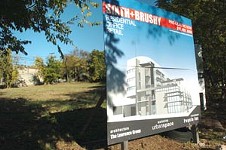El Futuro de East Cesar Chavez
Affordable housing advocates critique plans for Saltillo District
By Rachel Proctor May, Fri., May 5, 2006

Eddie Rodriguez took the stage at Martin Middle School Saturday morning and faced a piñata-adorned cafeteria stuffed with neighbors, housing advocates, and Capital Metro employees. The baby-faced, bespectacled state representative, who is also an Eastside resident, held up a report critiquing plans for the Saltillo District, Capital Metro's proposed Eastside redevelopment project, and outlined the kind of improvements the plan would need before neighbors could bestow their blessing on the project. "This is not a replacement to the Roma plan. We think of it as an enhancement," Rodriguez said. "We're not trying to say we're upset –"
In the back of the room, a slender, curly-haired activist named Daniel Llanes was feeling less conciliatory. "We are upset!" he shouted, interrupting Rodriguez. "We are upset about it!"
Sabino Renteria, a neighborhood activist and chair of the city's Community Development Commission, was sitting at one of the cafeteria tables, squished between several other affordable-housing scenesters. "Upset?" he wondered with a bemused smile. "I don't know ... I'm upset about my appraisals." The valuation of his home, just across from Martin Middle, jumped from $169,000 to $289,000 in a single year, a snapshot for the kind of gentrification pressures that Saltillo, done poorly, will exacerbate. The question is whether – if done well – Saltillo could help ease the crunch facing longtime residents of the suddenly hot Eastside.
The Saltillo District is a proposed high-density "transit village" on 11 mostly vacant acres between Fourth and Fifth Streets, just across I-35 from downtown. The proposed master plan, drafted at the behest of site owners Capital Metro by the San Francisco-based Roma Design Group, calls for one of those high-density "live-work-play" centers all the rage among city planners. It features multifamily housing over first-floor retail, happy pedestrians strolling about, and easy access to the commuter rail line that will run along the district's southern edge.
The community advisory group that has been monitoring the plan's progress over the last two years doesn't have any problem with the wide sidewalks or underground parking or the pedestrian "paseos" where kids can play. Rather, the CAG's complaint is that the Roma plan doesn't include enough family-sized affordable housing units and doesn't do enough to protect existing area businesses.
"The main thing is it does not protect the integrity of the neighborhood," said Susana Almanza, who serves on the CAG. "It does not enhance and does not complement what is already there."
What is already there is the East Cesar Chavez neighborhood, a deep-rooted, predominantly Hispanic community of big families and mostly lower-wage workers. The homes are about 60% owner-occupied, and the median family income is about $28,000, significantly lower than the city's average. The CAG wants the plan to reflect these realities, with 75% of the owner-occupied units three bedrooms or larger, and 50% of them affordable to families earning under 80% of the median family income, which is around $60,000 for a family of four. The CAG also wants rental units to have similar levels of affordability.
Roma and Capital Metro, however, get jittery about any affordability level above 25% and say that even at that level the project will need heavy subsidies to get off the ground. "We're going to have to use a very creative array of public funding and private investment to make the project happen," said Jim Adams, a principal of Roma.
The main issue is that before you can rent or sell affordably, you have to build affordably, and ballooning construction costs are making that harder by the month. Even rock-bottom work starts in the range of $75 a square foot, and that's before you add in density-enhancing features like elevators and structured parking, which can quickly push it up over $100. Plus, the proposed Saltillo project includes hefty infrastructure costs, such as the pedestrian malls, or relocating the train tracks that now bisect the blocks, which will leave Capital Metro $11 million in the hole before a single unit is built. The math becomes even harder if you factor in large, family-sized units.
Still, tax credits and other subsidies can go a long way. At the nearby Villas on Sixth, city and state subsidies cover about $12 million of the $20 million cost, and 85% of the units are affordable for families earning 50-60% of the median family income.
In addition to affordability, attendees of the Saturday open house urged Roma to find ways to keep all the new retail from swamping existing small businesses in the area. The CAG wants to see some sort of noncompete clause so, for example, Big Red Sun won't suddenly find itself with another über-refined cactus and décor destination a few blocks away. Attendees also wanted to ensure that residents will be able to spend their money on something other than boutiques, salons, cafe concoctions, and über-refined cacti.
"Families cannot survive on coffee and getting their hair done," said Austin Neighborhoods Council Vice-President Kevin Lewis.
Got something to say on the subject? Send a letter to the editor.












